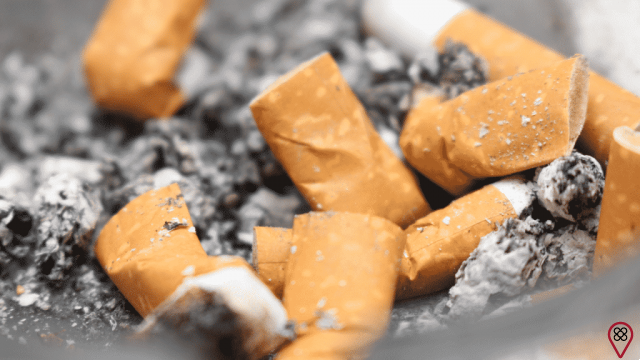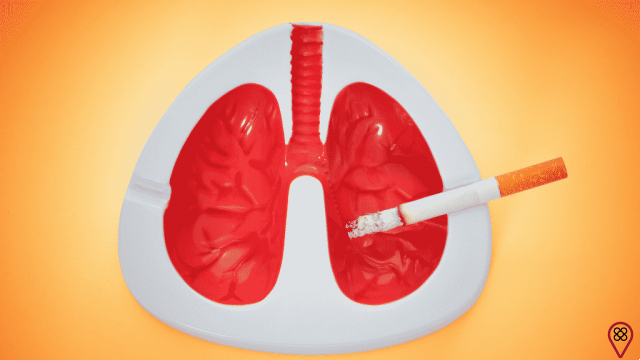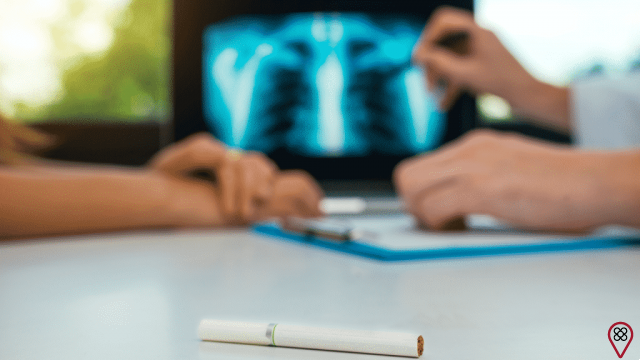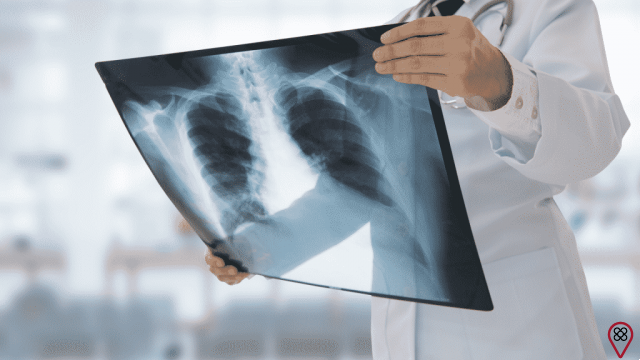Smoking
Cigarette smoking is recognized as a chronic disease caused by dependence on the nicotine present in tobacco products. According to the Review of the International Statistical Classification of Diseases and Related Health Problems (ICD-10), smoking is part of the group of mental and behavioral disorders due to the use of psychoactive substances. It is also considered the single largest preventable cause of illness and early death worldwide. Smoking is a risk factor for the development of the following types of cancer: acute myeloid leukemia; bladder cancer; pancreatic cancer; liver cancer; cervical cancer; esophageal cancer; kidney and ureter cancer; laryngeal cancer (vocal cords); cancer in the oral cavity (mouth); pharyngeal (neck) cancer; stomach cancer; colon and rectal cancer; cancer of the trachea, bronchi and lung (INCA, 2019).
In addition to being associated with chronic non-communicable diseases, smoking is also an important risk factor for the development of other diseases, such as tuberculosis, respiratory infections, gastrointestinal ulcers, sexual impotence, infertility in women and men, osteoporosis, cataracts, among others. others (INCA, 2019).
or tobacco
Tobacco is a plant (Nicotiana tabacum) whose leaves are used in the manufacture of different products whose active ingredient is nicotine, which causes addiction. There are several tobacco products: cigarettes, cigars, pipes, straw cigarettes, cigarillos, bidi, hookah tobacco, snuff, roll tobacco, electronic smoking devices and others. In Spain, Resolution No. 46 of the Collegiate Board of Directors of 2009, of the National Health Surveillance Agency (Anvisa), prohibits the commercialization, importation and advertising of any electronic smoking device. Tobacco smoked in any of its forms causes the majority of all lung cancers and is a significant risk factor for strokes and deadly heart attacks. Tobacco products that do not produce smoke are also associated with or constitute risk factors for the development of cancer of the head, neck, esophagus and pancreas, as well as for many oral pathologies (INCA, 2019).
What is a cigarette made of?
Cigarette smoke, for example, is composed of two phases: gaseous and particulate. In the gaseous phase, there is carbon monoxide, a gas with a high level of toxicity to the human body. Due to its chemical composition, the red cells of our blood, hemoglobin, which carry oxygen to all regions of the body, “marry” much better with it than with oxygen, gradually intoxicating the body, which can lead to problems, from loss of vision to death, depending on the degree of intoxication. Also in the gas phase, there is ammonia, whose inhalation is extremely irritating to the body.
However, the most harmful phase to the body is the particulate phase, in which nicotine and tar are found. Tar is a compound formed by numerous substances, 40 of which are proven to be carcinogenic - arsenic, nickel, benzopyrene, cadmium, pesticide residues, acetone, mothballs, p4/p6 phosphorus (compounds used to manufacture rat poisons), and even radioactive polonium 210 are present in it. Finally, perhaps the most harmful substance of all: nicotine. It is the active ingredient in tobacco and is responsible for lung cancer. It is a compound that acts on the central nervous system, activates functions in the body that accelerate the heart rate, being the cause of several cardiovascular diseases. It is also a major cause of gastric ulcers and, in large quantities, has an immediate impact on the parasympathetic nervous system.

What causes cigarette addiction?
Nicotine, which is found in all tobacco products (cigarettes, cigars, pipes, straw cigarettes, hookahs, among others) is the drug that causes addiction. This substance is psychoactive, that is, it produces the sensation of pleasure, which can lead to abuse and dependence. Nicotine dependence is included in the International Classification of Diseases of the World Health Organization – (ICD). When inhaled, it produces changes in the Central Nervous System, thus modifying the emotional and behavioral state of individuals, in the same way as with cocaine, heroin and alcohol. After nicotine reaches the brain, it releases several substances (neurotransmitters) that are responsible for stimulating the sensation of pleasure, thus explaining the good sensations that the smoker has when smoking (INCA, 2019).
With the continuous inhalation of nicotine, the brain adapts and needs increasing doses to maintain the same level of satisfaction that it had at the beginning. This effect is called drug tolerance. Over time, the smoker starts to need to consume more and more cigarettes. With dependence, the risk of contracting chronic non-communicable diseases also increases, which can lead to disability and death (INCA, 2019).
How does cigarette act chemically in the body?
Cigarette smoke is inhaled into the lungs, distributed to the circulatory system and causing nicotine to reach the brain in seven to 19 seconds. In addition, pulmonary capillary blood flow is rapid, and the entire volume of blood in the body travels through the lungs in one minute. In this way, substances inhaled by the lungs spread through the body with a speed almost equal to that of substances introduced by an intravenous injection. Cigar and pipe smoke is absorbed through the oral mucosa. In this way, there is no need to swallow it, as nicotine quickly reaches the brain from the oral cavity (INCA, 2019).

Check out 7 of the biggest damages of cigarettes to health surveyed by the Por Amor Saúde portal:
1 – Increases the risk of cancer
There is no escape: those who smoke are more likely to develop cancer. Did you know that 90% of lung cancer cases, for example, occur because of tobacco? And of course, the greater the consumption of cigarettes per day, the greater the risk of developing the disease. To give you an idea, according to the National Cancer Institute (INCA), 31.270 new cases of this tumor were estimated in 2018 alone.
What people need to know is that, despite being an extremely aggressive disease and causing many deaths, the problem is preventable precisely because it is closely associated with smoking. It is also worth mentioning that the thousands of toxic substances contained in cigarettes do not only affect the lungs. In fact, smokers are also more at risk for other types of cancer, such as:
- mouth;
- From trachea, pharynx and larynx;
- of esophagus;
- From pancreas;
- From kidneys;
- Liver;
- Bladder;
- Stomach;
- Of cervix;
- Acute myeloid leukemia.
2 - It's bad for those around you
Those who live with smokers at home, at work or other collective environments can also develop diseases due to exposure to cigarette smoke. In fact, believe it or not: the smoke released with tobacco has, on average, a 3 times higher content of nicotine and carbon monoxide, in addition to up to 50 times more carcinogenic substances than the smoke that the smoker himself inhales!

People who are exposed to this smoke for a short period may already have allergies, with cough, rhinitis, asthma and conjunctivitis, for example. Meanwhile, those who are exposed to smoke for long periods are more likely to develop more serious pathologies, such as lung cancer, respiratory diseases and even heart problems, such as a heart attack. The risk is even greater for children and pregnant women.
3 – Reduces life expectancy
The damage caused by cigarettes to health are so serious that they even reduce the life expectancy of those who smoke. Many people don't realize it, but smokers lose 10 years of life compared to people who don't smoke. The good news is that those who quit smoking can reverse (at least partially) this situation! If you stop smoking at:
- 30 years: gains about 10 years in life expectancy, reversing the risk of dying prematurely;
- 40 years: gains about 9 years in life expectancy;
- 50 years: gains about 6 years in life expectancy;
- 60 years: gains about 3 years in life expectancy.
In view of this, there is no doubt about how important it is to seek smoking treatment to quit the addiction as soon as possible and have quality of life again!
4 – Causes premature aging
People who smoke also look older, as another of the numerous negative consequences of smoking comes in the form of dermatological problems, such as the appearance of wrinkles, dryness and yellowing of the skin, in addition to hair loss.
All this happens because the toxic substances in cigarettes cause a decrease in blood circulation in the skin, a process called vasoconstriction. As a result, there is a reduction of collagen and elastin, decreasing the fibers that guarantee the firmness of the skin.

5 – It harms oral health
Another damage caused by cigarettes involves oral health, causing problems in the teeth and gums. In addition to a yellower smile, constant bad breath and taste problems, the smoker is more likely to have infections in the gums and in the structures that support the teeth.
When not treated properly, these cases can lead to tooth loss. This happens because smoking compromises the immune system, making it difficult to fight the bacteria that cause these diseases. Not to mention that smoking also hinders the good healing of the gum, interfering with the results of oral health treatments.
6 – Causes more than 50 diseases
Smoking is a disease (nicotine dependence) that is related to approximately 50 diseases, including several types of cancer (lung, larynx, pharynx, esophagus, stomach, pancreas, liver, kidney, bladder, cervix, leukemia), respiratory system diseases (pulmonary emphysema, chronic bronchitis, asthma, respiratory infections) and cardiovascular diseases (angina, acute myocardial infarction, arterial hypertension, aneurysms, stroke, thrombosis). There are still other diseases related to smoking: ulcer of the digestive system; osteoporosis; cataract; sexual impotence in men; infertility in women; early menopause and pregnancy complications. It is estimated that, in Spain, each year, about 157 thousand people die prematurely due to diseases caused by smoking. Smokers get sick twice as often as non-smokers. They have less physical resistance, less breath and worse performance in sports and sex life than non-smokers. In addition, they age faster and have yellow teeth, dull hair, wrinkled skin and the odor of tobacco (INCA, 2019).
Cigarette consumption can cause more than 50 diseases, including:
- Coronary diseases: smoking increases the probability of death from heart diseases, such as angina and heart attack;
- Circulatory problems: those who smoke are more likely to develop atherosclerosis, which can lead to mobility difficulties and pain;
- Pneumonia: infection that affects more smokers, as they have an impaired immune system;
- Aortic aneurysm: abnormal and localized dilatation of the aorta, which can cause it to rupture;
- Chronic obstructive pulmonary disease: the smoker is more susceptible to this chronic disease that promotes the reduction of the ability to breathe due to obstruction in the airways;
- Osteoporosis: this disease that weakens the bones is recurrent in smokers, because nicotine interferes with the good absorption of calcium;
- High cholesterol: Smoking increases the risk of clogged arteries because it raises the levels of bad cholesterol (LDL) in the blood.

7 – It brings problems in pregnancy
A pregnant woman who smokes can put the health and even the life of the baby at risk, as the harmful substances in tobacco compromise the delivery of oxygen and nutrients to the fetus. Cigarette smoking during pregnancy can thus cause premature birth and low birth weight or sudden death syndrome, which occurs shortly after the baby is born.
Benefits of Quitting Smoking and What Happens When You Stop:
- Improved physical ability
- taste improvement
- improved sense of smell
- Reducing the risk of cancer
- Reducing the risk of cardiovascular and respiratory diseases
- Increased life expectancy
- Tobacco breath termination
- Reduction of health expenses
- Savings by not buying cigarettes
- A GREAT EXAMPLE for friends, family, especially children and grandchildren.
What happens:
- In 20 minutes: blood pressure and heart rate return to normal
- In 8 hours: carbon monoxide levels return to normal
- In 1 day: reduced risk of heart attack
- In 3 days: relaxation of the bronchi and increase in breathing capacity
- In 2 to 12 weeks: improvement in blood circulation.
- In 1 to 9 months: reduction of cough and airway infections, improvement of breathing, cleaning of the lungs and improvement in physical capacity.
- At 1 year: reduced risk of coronary heart disease by 50%.
- In 10 to 15 years: The risk of death from coronary heart disease equals that of a person who has never smoked.
- In 15 to 20 years: Cancer risk approaches that of a person who has never smoked.
The role of the lungs
The primary function of the lungs is to carry out gas exchange, that is, to absorb oxygen from the air you breathe and to expel carbon dioxide (a gas that can be toxic) from the body through exhalation. This is a vital process for the body to function properly. They are the main organs of the respiratory system and occupy most of the chest cavity. They have a reddish-grey color and a spongy consistency. The right lung is divided into three parts (also called lobes), being slightly larger than the left lung, which is divided into two lobes.
Lung cancer
Lung cancer is the most common type of malignant tumor and the leading cause of cancer death among men and women. Lung cancer is the second most common type of cancer in Spain, after non-melanoma skin cancer. And it is also one of the deadliest (PFIZER, 2019). In 90% of diagnosed cases, it is associated with the consumption of tobacco products. In general, it originates in the cells that line the bronchi and parts of the lung, such as the bronchioles and alveoli, and, if not treated early, it can spread to other parts of the body.

There are two main types of lung cancer: small cell and non-small cell, the most common, accounting for 85% of cases. Among the small cell tumors, the undifferentiated small cell carcinoma stands out, which is subdivided into three subtypes: lymphocytoid (oatcell, fast growing, great capacity for dissemination and brain invasion), intermediate and combined. On the other hand, non-small cell tumors are composed of three different types: squamous cell carcinoma (25% to 30% of cases start in the cells that line the interior of the airways), adenocarcinoma (40% of cases start in the alveoli and slow growth) and large cell carcinoma (10% to 15% of cases arise in any part of the lung and tend to grow and spread rapidly). In addition to these types, other tumors that can affect the lungs are carcinoid tumors (less than 5% of cases), adenoid cystic carcinomas, lymphomas and sarcomas. The lung can also be affected by metastases from cancers originating in other organs, such as the pancreas, breast, kidney or skin. In this case, the tumors are treated like the cancer of the site of origin. Lung cancer mainly occurs in older people. About 2 in 3 people diagnosed with lung cancer are over 65, and less than 2% of cases are diagnosed in people under 45. The average age at diagnosis is 70 years (HOSPITAL SÍRIO-LIBAÊS, 2019).
Signals and symptons
According to the National Cancer Institute (INCA), symptoms usually don't occur until the cancer is advanced, but some people with early-stage lung cancer do have symptoms. The most common are:
- Persistent cough
- sputum with blood
- Chest pain
- Hoarseness
- Worsening shortness of breath
- Weight loss and appetite
- Recurrent pneumonia or bronchitis
- Feeling tired or weak
In smokers, the usual rhythm of coughing is altered and attacks appear at unusual times.
If you go to the doctor when you first notice any of these symptoms and you have lung cancer, the disease may be diagnosed at an early stage, when treatment is most likely to be effective.
What increases the risk?
According to the National Cancer Institute (INCA), smoking is the leading cause of lung cancer. Exposure to air pollution, repeated lung infections, vitamin A deficiency and excess, chronic obstructive pulmonary disease (pulmonary emphysema and chronic bronchitis), genetic factors and a family history of lung cancer favor the development of this type of cancer. Advanced age: Most cases affect people between 50 and 70 years old.

The risk of lung cancer and death from the disease increases the greater the intensity of exposure to smoking. Lung cancer mortality among smokers is about 15 times higher than among people who have never smoked, while among ex-smokers it is about four times higher.
Other risk factors are: occupational exposure to chemical or physical agents (asbestos, silica, uranium, chromium, alkylating agents, radon, among others), drinking water containing arsenic, high doses of beta-carotene supplements in smokers and ex-smokers.
Rural workers, construction, tannery, metal smelting, industries (aluminium, rubber, cement and plaster, printing and paper, textile, metallurgy, heavy metal, nuclear, electronics, aircraft, medical devices, glass, fertilizers), mining , battery factory, pigment production, hydraulic firefighters, plumbers, electricians, auto mechanics, miners, painters, welders, glass blowers, insulated work on ships and docks, leather care, cleaning and maintenance may be at increased risk of disease development. If the worker exposed to any of the agents or exposure circumstances mentioned above also smokes, the risk of cancer may be much greater, due to the synergistic effect between smoking and some chemical and/or physical agents.
How to prevent?
According to a text originally published on the American Cancer Society website, on 01/10/2019, freely translated and adapted by the Oncoguia Institute Team, not all lung cancers can be prevented, but there are some ways to reduce the risk of contracting lung cancer. disease, such as modifying exposure to risk factors:
Do not smoke. The best way to reduce your risk of lung cancer is to not smoke and to avoid passive exposure to cigarette smoke. If you stop smoking before you develop cancer, your damaged lung tissue will gradually repair itself. Regardless of your age or how long you've smoked, quitting can reduce your risk of the condition.

Avoid exposure to radon. Radon is an important cause of lung cancer. You can lessen and avoid exposure to radon by checking for its presence in your home.
Limit exposure to carcinogenic chemicals. Avoiding exposure to known carcinogenic chemicals, in the workplace and elsewhere, is also important. People who work in places where they are exposed to these products are closely monitored so that exposure is as little as possible.
Maintain a healthy diet. A healthy diet with fruits and vegetables can also help reduce your risk of lung cancer. Some evidence suggests that a diet rich in fruits and vegetables helps protect from disease in smokers and nonsmokers. But any positive effect of fruits and vegetables on lung cancer risk would be much smaller than the increased risk from smoking. Attempts to reduce the risk of lung cancer in smokers through high doses of vitamins or the like have not been successful so far. In fact, some studies have shown that beta-carotene, a nutrient related to vitamin A, appears to increase the incidence rate of the disease in these people. Some lung cancer patients have no clear risk factors. While it is known how to prevent most types of lung cancer, it is not yet known how to prevent all types.
early detection
According to the National Cancer Institute (INCA), early detection of cancer is a strategy to find a tumor at an early stage and thus provide a greater chance of treatment. Detection can be done by means of investigation with clinical, laboratory or radiological exams, of people with signs and symptoms suggestive of the disease (early diagnosis), or with the use of periodic exams in people without signs or symptoms (screening), but belonging to groups most likely to have the disease.
There is no scientific evidence that lung cancer screening in the general population has more benefits than risks, and therefore, to date, it is not recommended. Recent studies have shown the possibility that performing a low-dose radiation CT scan in heavy smokers (one pack a day for 30 years), over 55 years of age, may reduce mortality from this cancer. However, there are risks linked to the investigation that follows in positive cases. Therefore, the decision whether or not to perform this test should be discussed between the patient and the doctor.
Early diagnosis of lung cancer is possible in only part of the cases, as most patients only show signs and symptoms in more advanced stages of the disease. The most common signs and symptoms that should be investigated are:
- Persistent cough and hoarseness
- Bleeding from the respiratory tract
- Chest pain
- Difficulty breathing
- Weakness and weight loss with no apparent cause
Most of the time these symptoms are not caused by cancer, but it is important that they are investigated by a doctor, especially if they do not improve within a few days.
Diagnosis
Chest X-ray and CT scan are the initial tests to look for a suspected lung cancer. In asymptomatic patients at risk of lung cancer or with suggestive early symptoms (weight loss, persistent cough, coughing pattern different from usual), chest X-ray is of great value (INCA, 2020).

Bronchoscopy (respiratory endoscopy) should be done to evaluate the tracheobronchial tree and eventually allow for biopsy (removal of small pieces of the tumor with a needle for examination). It is essential to obtain a definitive diagnosis by the pathology. Once the disease is confirmed, staging is carried out, which assesses the stage of evolution, that is, it verifies whether the disease is restricted to the lung or has spread to other organs. Staging is done through various tests, such as tomography-guided lung biopsy, bronchoscopy biopsy, chest tomography, nuclear resonance, PET-CT, bone scintigraphy, mediastinoscopy, echobronchoscopy, among others (INCA, 2020).
Treatment
According to the National Cancer Institute (INCA), the treatment of lung cancer requires the participation of a multidisciplinary group, formed by an oncologist, thoracic surgeon, pulmonologist, radiotherapist, interventional radiologist, nuclear physician, nurse, physiotherapist, nutritionist and social worker.
For adequate treatment planning, it is necessary to make a histological diagnosis and staging to define if the disease is located in the lung or if there are foci in other organs. For patients with localized disease and, particularly, without an enlarged lymph node (ganglion) in the mediastinum (region between the two lungs), treatment is surgical, followed or not by chemotherapy and/or radiotherapy.
For those with disease located in the lung and lymph nodes, treatment is with radiation and chemotherapy at the same time. In patients with distant metastases, treatment is with chemotherapy or, in selected cases, with targeted therapy-based medication.
Therefore, the treatment of lung cancer depends on the histological type and stage of the disease, and can be treated with surgery, chemotherapy or radiotherapy and/or combined modalities.

Treatment modalities
Surgery
Surgery, when possible, consists of removing the tumor with a safety margin, in addition to removing the lymph nodes close to the lung and located in the mediastinum. It is the treatment of choice for providing better results and disease control. About 20% of cases are amenable to surgical treatment. However, in the vast majority (80%-90% of cases), surgery is not possible at the time of diagnosis, due to the extension of the disease (advanced stage) or the debilitated clinical condition of the patient.
Surgeries to treat lung cancer can be:
- Segmentectomy and wedge resection: when a small part of the lung is removed (only the segment or part of the segment that surrounds the tumor), reserved for patients with small tumors and who cannot support major surgeries due to age or clinical and/or respiratory conditions limited.
- Lobectomy is the surgery of choice for the treatment of lung cancer. The entire lung lobe (group of segments) where the tumor is located is removed. It is the most suitable for removing all the disease anatomically.
- Pneumonectomy: is the removal of an entire lung (its indications are limited and restricted). Procedure with greater morbidity and not tolerated by some patients.
Chemotherapy
Chemotherapy treatment aims to destroy cancer cells, as well as reduce tumor growth or alleviate the symptoms of the disease. It may have undesirable side effects, not being tolerated by all patients.
You may also like
- Find out how to get rid of cigarette addiction
- Learn to quit smoking once and for all
- Find great natural tips to quit smoking
Radiotherapy
It uses radiation to destroy cancer cells. It can be used before or after surgery. It can also cause a number of side effects (such as pneumonitis and esophagitis).
Target therapy:
It is a new form of cancer treatment, often used in patients whose tumor has certain molecular (genetic) characteristics. These medications have been reserved for the treatment of advanced diseases. New studies are underway to select the group of patients that will best benefit from this treatment.

























